 |
The
Great Eastern
|
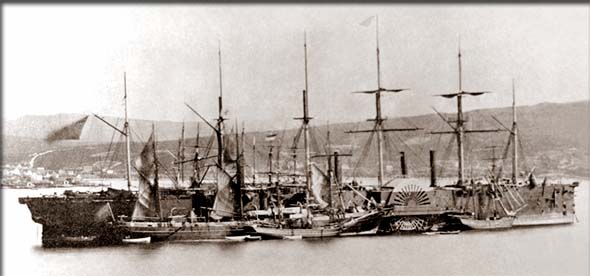
It was
the largest ship of its era. So massive it was renamed the Leviathan
for its 1858 launch. Though the vessel was a failure at the
Far East passenger trade that it was designed for, it later
achieved great success as it laid the first fully effective
underwater Atlantic cable while operating under its proper name,
The Great Eastern.
By 1852
Isambard Kingdom Brunel was already a well-known British engineer
with a list of successful projects to his credit: Several bridges
with innovative features, the building of Britain's new Great
Western Railway, and also the construction of two ships: the
Great Western and the Great Britain. These last two projects,
both passenger ships, had been undertaken to take advantage
of the growing trade between Britain and North America. With
their success, Brunel wondered if there might be a need for
a passenger ship designed to handle traffic to the Far East,
visiting ports in China and Australia.
Such
a ship, he reasoned, would need to be huge. Large enough that
could travel around the world without fueling. Such a big ship
would also benefit from the so called "economy of scale." For
example, it might not need a much larger crew than a smaller
ship, but it would be able to carry many more passengers and
cargo, which would translate into more profit.
|
Seven
Quick Facts
|
|
-Length:
692
feet (211m)
|
|
-Beam:
83
feet (25m)
|
|
-Design:
Iron hull powered by sails, steam paddles and steam propeller.
|
|
-Construction
dates: 1854 - 1859
|
|
-Designer:
Isambard
Kingdom Brunel
|
|
-Function:
Passenger ship later converted to laying submerged
telegraph cable.
|
|
-Other:
Designed for 4,000 passengers and 400 crew.
|
With
this in mind, Brunel sketched out a picture of such a ship in
his notebook with the caption "Say 600 feet x 65 feet x 30 feet."
A ship
of such dimensions not be easy to build, however. It would be,
by volume, more than four times as large as any ship currently
in service at the time. Still, Brunel liked a challenge and
he gave the design to John Scott Russell, a navel engineer he
respected, who had already constructed several ships designed
by Brunel.
Scott
calculated such a ship would have a displacement of about 20,000
tons and would need at least 8,500 horsepower to achieve a speed
of 14 knots (about 16 mph). One novel feature that the ship
was designed with was multiple means of propulsion. It would
have masts and sails to take advantage of the wind and both
side paddles wheels and a screw (what most people today would
probably refer to as a propeller) which would be powered by
steam engines.
Eastern
Steam Navigation
Brunel
and Scott approached the Eastern Steam Navigation Company about
their idea. Eastern Steam wanted to get into the Far East trade
but had lost an important contract from British General Post
Office to transport mail to the East Asia. The only way they
might be able to make a profit without it was by utilizing such
an efficient ship as Brunel was proposing.
In July
of 1852, the company reviewed the proposal and decided to build
the ship, putting Brunel in charge as the chief engineer. Brunel
then started looking for vendors to build the major components
of his design: the hull, paddle engines and screw engines.
|
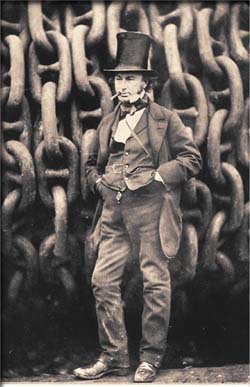
Isambard Kingdom Brunel
|
Brunel's
estimate for the cost of building the ship came to £500,000.
Scott's company, however, put in a bid of only £377,200 to successfully
win the contract. Brunel trusted Scott's engineering competency
and did not question the bid. Scott, however, was a better engineer
than businessman and his low figure was to cause serious problems
with finishing the ship's construction.
Construction
Assembly
began in the spring of 1854 on a leased plot of land next to
Scott's shipyard in Millwall, London. Nothing as big as this
ship had ever been built before and the problems of how to erect
it were significant. No dry dock was nearly big enough to hold
it. It was finally decided to build it lengthwise next to the
river with the idea of sliding sideways into the water when
the time came.
Brunel's
innovative design included a double, iron-skinned hull, so that
if the outer hull got a hole in it, the inner hull would still
keep the water out. Such a design was unheard of at the time,
but now is required of all modern ships.
Everything
about the ship was big. Its crew complement would be 400 and
it could carry 4,000 passengers (Twice that of other ships operating
in the same era). The paddle wheels on the sides of the ship
were immense - 54 feet (17m) in diameter. The propeller was
also enormous, being 24 feet across (7.3m). The vessel also
had a record five smoke funnels for the engines and six masts
for sails.
The
work progressed, but by the beginning of 1856 it became clear
that Scott's company was in financial trouble. Eventually his
bankers agreed to turn the ship over to Eastern Navigation and
lease his yard to them so that they could complete the ship
themselves. A year of work went by and under pressure to get
the ship out of the yard and into the water, Brunel reluctantly
agreed to try and launch the vessel on November 3rd of 1857.
The
Eastern Navigation Company sold 3,000 tickets to people who
wanted to see this enormous ship slide into the river that day.
They were disappointed. The steam winches that were supposed
to drag the ship into the water were not up to the task of moving
the vessel which was 692 feet (211m) long and 83 feet (25m)
wide. Brunel tried again several more times before successfully
launching her on January 31st of 1858.
By then
the cost of building the ship and launching her had brought
Eastern Navigation to the brink of bankruptcy. In order to finish
the ship's interior it was decided to create a new company,
the Great Ship Company, which bought the ship from Eastern Navigation.
Ironically, despite earlier problems, Scott Russell's company
was allowed to bid for and win this part of the contract, too.
Work started in January of 1859 and finished in August.
|
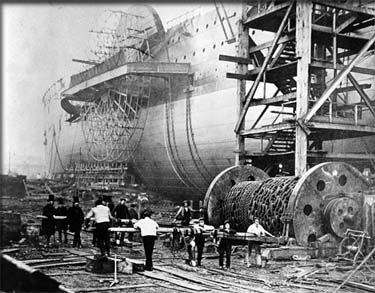
The
Great Eastern under construction in 1858.
|
Maiden
Voyage Explosion
The
maiden voyage of the vessel, which started on September 6th
of 1859, was marked by an unfortunate incident. As the Great
Eastern moved into the English Channel, a huge explosion rocked
the vessel and one of the funnels was blown off. Six men were
killed and nearly as many were seriously injured. The explosion
was caused when feed water pipes for the boilers which ran around
the funnel to cool it and pre-heat the water had been accidentally
closed off. As the funnel warmed the water in the pipes eventually
it turned to steam, expanded, and the pipes, not designed to
hold back that kind of pressure, gave way.
The
ship was not in danger of sinking, however, and the voyage continued
to Weymouth, where repairs were made.
Burnel,
for health reasons, was not aboard the ship when it made its
maiden voyage. A heavy smoker, he suffered a stroke in 1859
and died just before the ship made its first trans-Atlantic
trip.
Though
the ship was designed for voyages to the Far East, it turned
out that there was never the amount of traffic going in that
direction to support its operation. Instead, from 1860 through
1863, she was put into trans-atlantic service between England
and the United States. However, the competition was so stiff
the Great Ship Company never became profitable and they decided
to sell the ship in 1864.
Several
attempts were made to sell the ship before it was bought by
the newly-formed Great Eastern Steamship Company. Instead of
putting the ship back into passenger service, however, the owners
had another idea. They chartered it to Telegraph Construction
and Maintenance Company and retro-fitted it to lay undersea
telegraph cables. It was in this new role that the Great Eastern
would have its most outstanding successes.
Laying
the Atlantic Cable
In 1837
electrical telegraphs had been developed independently in both
Europe and in North America. Within two decades both continents
were crisscrossed by wires connecting almost all major cities,
allowing same day communications between almost any urban location
on those continents. Communications between Europe and North
America, however, were still limited by the length of time it
took a ship carrying a message to cross the seas: At least 10
days.
|
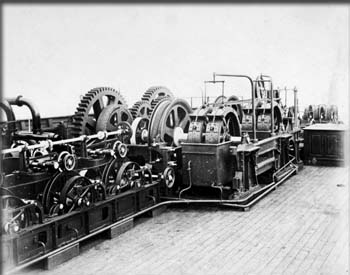
Some
of the cable laying machinary on the deck.
|
The
first attempt to lay a telegraph cable across the Atlantic was
completed in 1858. Unfortunately because of poor quality materials,
the cable stopped functioning after three weeks. However, this
did prove that such a plan was viable and in a new effort, using
the refitted Great Eastern was started.
To this
end one of the funnels was removed along with some boilers.
Many of the staterooms were also gutted and large open topped
tanks, designed to hold 2,300 nautical miles of coiled cable,
were installed.
In July
of 1865, Great Eastern left Valentia Island, Ireland, headed
for Canada. All went well for 1,200 miles, when suddenly the
cable snapped and the end dropped into the sea. Many attempts
were made to use grappling hooks to capture it again, but they
all failed.
An attempt
to lay another cable was made in 1866. This time the Great Eastern
set the cable without incident and on July 27th, 1866, arrived
at the tiny fishing village in Newfoundland called Heart's Content.
The ship managed to lay an average of 120 miles of cable a day.
Immediately
after laying the new cable the ship went back to sea and made
another attempt at recovering the cable lost in 1865. This time
the crew was successful in recovering it. On board the Great
Eastern, the old cable was spliced with a new one. Then the
ship headed back to Hearts Content laying the 2nd cable. By
September 8th a second cable was finished, ensuring that from
that day forward the North American and European continents
would be linked by telegraph.
The
ship continued laying submerged cables until 1870. Attempts
after that were made to put her back into passenger service,
but this failed. For a few years she was used as a showboat,
a floating concert hall and gymnasium, but eventually in 1888
she was scrapped. A sad end for a noble ship with a design that
was far ahead of its time.
|
The
Great Eastern beached prior to being scrapped.
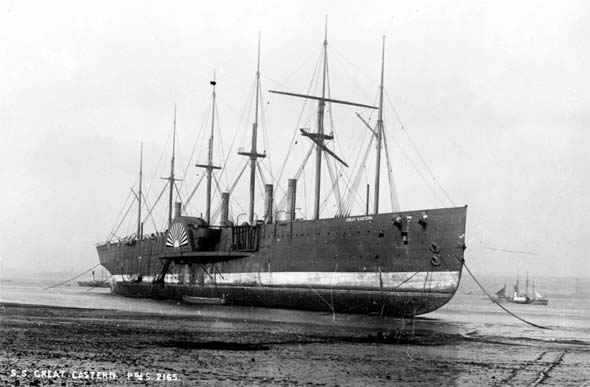
|

Copyright
Lee Krystek 2016. All Rights Reserved.